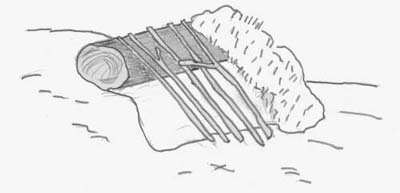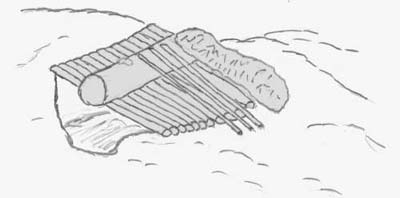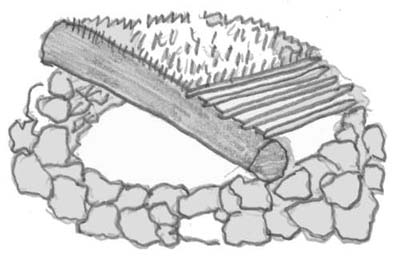Pioneering - Shelters - Natural

Downloadable Material
![]() A list of downloadable pioneering projects, including camp gadget flashcards
A list of downloadable pioneering projects, including camp gadget flashcards
Introduction
Construction of a shelter is a basic survival skill, and in a safe enviroment, great fun and exciting to be sleeping in your own hand made house.
Materials and requirements vary but many shelters can be made or adapted from natural materials lying to hand quite easily.
Bough

If a bough of a tree happens to fall down towards the ground then it may well form a ready made shelter (espically useful if the tree is conifer type, as the broad leaves mean little extra work needs to be done to waterproof your shelter). Obviously you will have to take care that a broken branch is not about to come crashing down on your head in the middle of the night. If in doubt, or if you are constructing this shelter using a separate branch, lash the branch at the tree with a sturdy (square) lashing.
To finish off your shelter you may want to weave extra leaves and branches into the 'roof' to make it more resistant to the wind and rain.
Fallen Trunks

As with the natural hollow shelter a fallen trunk or large log can make a useful windbreak. If you need a larger shelter simply excavate the ground on the leeward side (taking care to leave the trunk in a safe position!). Again a sloping roof laid against the log made from branches overlaid with turf or leaves will provide a good roof to keep the warmth in and the water out.
Hollow

A natural hollow can save you a lot of time and effort in constructing a shelter. Even a relatively small hollow can provide some measure of comfort and protection and will save you some effort. A roof should be the first modification you make, taking care to slope it so that any runoff will not enter your shelter.
You only need a few short branches with a light log laid across the top. This will serve to 'hold' the roof down but you can then stack smaller branches against the log to give your roof a decent slope. If you finish off the roof with turf or leaves and twigs you will have a simple shelter against the wind and rain.
Stone Wall

If there is little natural shelter available on an open ground area, you may want to consider some type of stone shelter. It is also useful to construct a stone surrounding to any shelter that uses a 'hollow' in order to increase the overall height of the shelter itself (so you do not have to crawl all the time in your shelter).
The premise is simple, build a layer of stones around your shelter. To make the walls waterproof, fill the gaps with turf and foliage mixed with mud. This will dry to form a 'mortar'. Be sure to do this on the lower level to prevent water entering. Similarly you will want to construct a roof as with the other shelters.